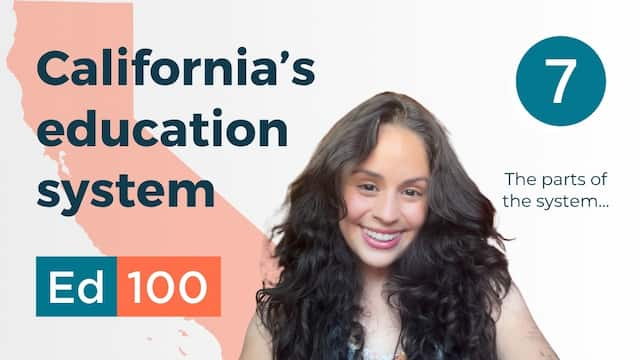
People are sometimes surprised to learn that the federal government plays a small role in funding public schools.
In This Lesson

What portion of education funding comes from the federal budget?
What does the federal government provide schools?
How do federal policies influence education in California?
What was No Child Left Behind (NCLB)?
What was Race to the Top?
What is the Every Student Succeeds Act (ESSA)?
▶ Watch the video summary
★ Discussion Guide
In California, less than a tenth of the money for public schools comes from the federal budget, most of it directed to districts and schools. The funds play an equalizing role, helping to pay for school lunch and breakfast programs and teacher salaries for early education in disadvantaged communities. At present, most big decisions about education policy are made at the state or local level, with the federal government playing only a small (but vital) role.
As this lesson will explain, this was not always the case.
The federal budget provides about 10% of school funding. It varies by year.
The federal department of education (DOE) also plays an essential role in enforcing civil rights in education. Data assembled by the federal government is essential to overcome states' noisy, varying approaches and figure out a little bit about what works. See organization chart and FY2025 budget.
In the early 2000's, under the Bush and Obama administrations, federal education law and funding programs were politically prominent. Why? Because a small portion of the funding was contingent — that is, it came with strings attached. The amount of contingent funds at stake in these federal policies was tiny in context, but it was enough to have a huge impact on education policies throughout the country.
Under the presidency of George W. Bush (2001-2009) the role of the federal government in public education expanded. In particular, federal funds were directed toward measuring the effectiveness of schools, especially in service of minority students. Annual universal testing, a centerpiece of this strategy, won widespread bipartisan support. This was an important change, because it drew attention to achievement gaps and spurred districts to take action. Prior to universal testing, it was possible to pretend that all kids were doing great in school. (It's still possible until the end of grade 3, when testing starts.)
In the quest to improve education outcomes, an important role of the federal government has been to collect data about schools' results. For a time, another important role was to create incentives for experimentation and evaluation.
What was "No Child Left Behind"?
NCLB made federal funding "contingent"
A little history helps clarify the evolving federal role in education. The Elementary and Secondary Education Act (ESEA) was a cornerstone of President Lyndon Johnson’s "War on Poverty." A major surviving function of ESEA (Title I) provides federal money to support schools that serve low-income children. (Of course, there's a lot more to it. Here's a good summary of all of the "titles" of ESEA.)
From 2002 to 2015, ESEA was re-branded as the No Child Left Behind Act (NCLB), with some important changes. NCLB was a muscular policy: it made federal funding contingent. In order for districts to access certain federal funds previously provided to districts without conditions, states were required to do some specific things: adopt meaningful standards, administer standardized tests in English and Math based on the standards, and hold schools and districts accountable for the results. Schools that failed to reach improvement targets were identified, and could face consequences.
A broad bipartisan coalition voted NCLB into law with a romantic 12-year goal: By 2013-14, all students would score at a proficient level on state tests. It was an impossible goal from the outset — for example, to have all English learners score proficient in English is by definition not achievable — but to have aimed lower would have been unseemly. Legislators deferred the problem to their successors, assuming that subsequent legislation would amend away the unreasonable bits. It didn't happen.
Though passed as a bipartisan measure, NCLB eventually lost the support of both Democrats and Republicans as more and more schools fell short of the gradually-rising expectations in the law.
States were eager for relief from the provisions of NCLB, but Congress was unable to forge a compromise to take action and replace it. The law technically expired in 2007, but without a replacement it remained strangely alive, sort of. Like a zombie.
Big federal money with little strings attached
In 2008, the Great Recession devastated state and local revenue for public education. To prevent school systems from collapse, Congress quickly passed a huge ($787 billion) economic stimulus package that included about $100 billion in federal funds for education. Most of these funds were delivered to states without significant conditions, but about $4 billion — a small sum in context — was set aside for Race to the Top, a competitive grant program. Districts had the opportunity to receive grants by developing plans with specific policies in four areas:
- Adopting "internationally benchmarked standards and assessments that prepare students to succeed in college and the workplace and to compete in the global economy";
- Building data systems that measure student growth and success, and inform teachers and principals about how they can improve instruction;
- Recruiting, developing, rewarding, and retaining effective teachers and principals, especially where they are needed most; and
- Turning around the lowest-achieving schools.
As state leaders considered the federal "carrot" offered by the Race to the Top, they also faced a "stick." Massive numbers of schools and districts were failing to increase student test scores fast enough to meet the optimistic targets established by NCLB. These targets were known as Adequate Yearly Progress (AYP) .
Under the leadership of Secretary of Education Arne Duncan, in 2012 the Department of Education began working with states to apply for waivers to the outdated law in exchange for assurances that they would adopt specific policy changes. Virtually all states eventually applied for and received waivers to their AYP targets. The state of California was an exception — it did not apply for a statewide waiver, though a group of ten California districts applied independently. The group included Los Angeles Unified, the second largest district in the nation.
The "Every Student Succeeds Act" (ESSA)
At the end of 2015, Congress passed the Every Student Succeeds Act (ESSA) to replace NCLB. Passed with strong bipartisan support as a last act of the Obama administration, the measure took effect in 2017-18 under the oversight of Betsy DeVos, the US Secretary of Education.
ESSA substantially trimmed the federal role in education. It requires that states identify their lowest-performing schools and take action to improve at least the lowest-performing 5% of them. But it gives states lots of flexibility about how to identify schools that need help and what to do to help them. (Here's California's list.) This reduction in the federal role in education was matched with reduced funding: between 2011 and 2016, federal sources dropped from a bit over 10% of funding for education to less than 6%.
Many fundamental ideas of NCLB remain in ESSA. States must still:
- Target support for low performing schools and disadvantaged children. California does this with the Local Control Funding Formula (LCFF) and the California Collaborative for Education Excellence (CCEE), described further in Lesson 7.9.
- Administer assessments each year in math and English/language arts for students in grades three through eight, and once in high school.
- Improve the quality and effectiveness of teachers, principals, and other school leaders.
The ESSA law runs over 1,000 pages, enough reading to keep you up many nights. To save you some time, the Alliance for Educational Excellence has created a series of summary documents and videos about it.
Other federal programs
The federal government supports many other programs that relate to education, including child nutrition and special education. During the COVID-19 pandemic (2020-2022), the federal government provided nearly $200 billion in emergency funding to states and school districts to sustain public education. The last of these funds (ESSER) dried up in 2024, creating a fiscal cliff that added to the complexity of the moment for school districts.
Changes under Trump
In 2025, early executive actions of the second Trump administration called for substantial reductions in federal spending on education. Most of the cuts targeted colleges, but some related to K-12, especially for programs related to ethnic studies, teacher training, data systems, and research. For more, see our blog.
This lesson explored the role of the federal government in education. The previous lesson explored the role of the state in education. The next lesson will be closer to home.
This lesson was updated in April 2025.
Quiz×
CHAPTER 7:
And a System…
-
And a System…
Overview of Chapter 7 -
The Role of State Government in Education
California’s Constitutional Responsibility -
The Federal Government and Education
Small money, Big Influence -
School Districts in California
What do School Districts Do? -
County Offices of Education
Oversight and Regional Services -
Teachers' Unions in California
What do Teacher Unions Do? -
Ballot Initiatives and Education
California's Initiative Process and How It Affects Schools -
Who Influences Education?
Politics, Philanthropy and Policy -
Accountability in Education
Who Monitors the Quality of Schools? -
What to Do with Failing Schools
Interventions and Consequences in California -
The LCAP
Annual Plans for California School Districts
Related
Sharing is caring!
Password Reset
Search all lesson and blog content here.
Login with Email
We will send your Login Link to your email
address. Click on the link and you will be
logged into Ed100. No more passwords to
remember!















Questions & Comments
To comment or reply, please sign in .
Carol Kocivar April 25, 2025 at 4:32 pm
The link below has a compilation of the state responses to education threats.
https://www.cde.ca.gov/nr/fa/
Carol Kocivar April 25, 2025 at 1:16 pm
California Attorney General Rob Bonta today, leading a coalition of 19 attorneys general, filed a lawsuit challenging the U.S. Department of Education’s efforts to withhold federal funding from state and local agencies that refuse to abandon lawful programs and policies that promote equal access to education in K-12 classrooms across the nation.
Carol Kocivar April 25, 2025 at 1:09 pm
Check Education Week for a full list of law suits and education policies that are challenged.
https://www.edweek.org/policy-politics/see-all-the-lawsuits-filed-over-trumps-education-policies/2025/03
Carol Kocivar April 25, 2025 at 12:51 pm
NYT 4/4/2-25
The justices allowed the Trump administration to temporarily suspend $65 million in grants for teacher training in poor and rural areas.
The temporary pause will remain in effect while the case is appealed.
Carol Kocivar April 25, 2025 at 12:49 pm
NYT 4/24/2025
In three cases, federal judges paused the administration’s effort to cut off money from public schools with diversity and equity programs.
Appeals are expected.
https://www.nytimes.com/2025/04/24/us/trump-public-school-funds-dei.html
Carol Kocivar March 13, 2025 at 6:47 pm
Carol Kocivar June 14, 2022 at 6:16 pm
https://www.cde.ca.gov/fg/cr/relieffunds.asp
Carol Kocivar June 14, 2022 at 6:16 pm
https://www.cde.ca.gov/fg/cr/relieffunds.asp
Jeff Camp December 22, 2020 at 2:10 pm
Kari May 30, 2019 at 11:21 am
Jeff Camp January 23, 2019 at 12:12 pm
Jeff Camp March 10, 2017 at 11:25 am
Carol Kocivar February 3, 2016 at 11:24 am
Leading education experts share their views on the "Implications of Every Student Succeeds Act for California and equity ".
http://edsource.org/2016/webinar-video-implications-of-every-student-succeeds-act-for-california-and-equity/93776?utm_source=Feb.+3+daily+digest+--+Sue&utm_campaign=Daily+email&utm_medium=email
Mary Perry March 30, 2015 at 10:11 am
The action is long overdue and the delay has been frustrating. But perhaps the years of procrastination will end up with a more thoughtful approach to accountability than what we now have. This brief by two of the nation's leading education policy thinkers, Paul Hill and Linda Darling-Hammond, provides some hope. It's here: https://edpolicy.stanford.edu/publications/pubs/1324. These two are often on opposite sides of the political and philosophical divide regarding education, but they are apparently united in this advice to Congress.